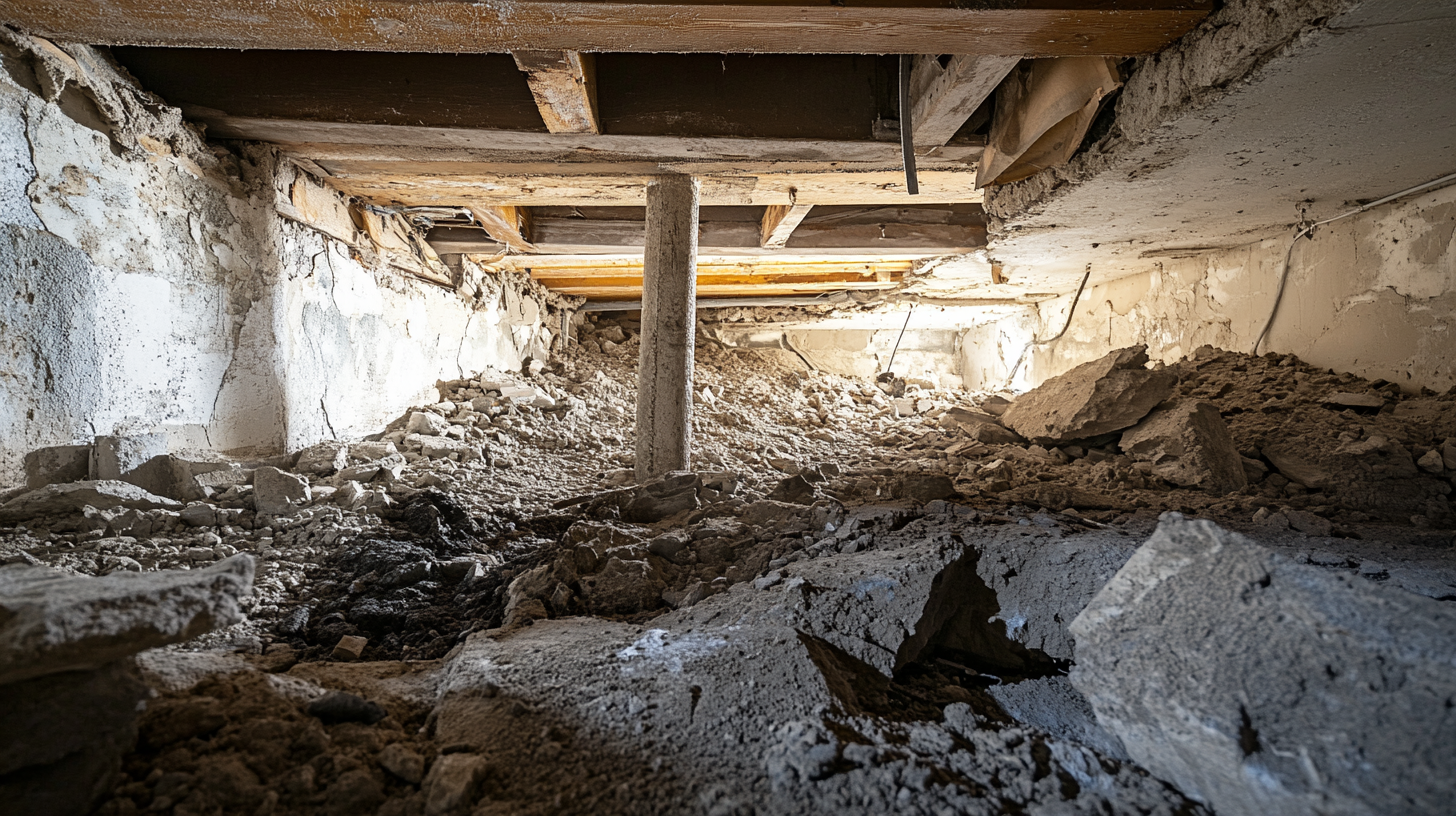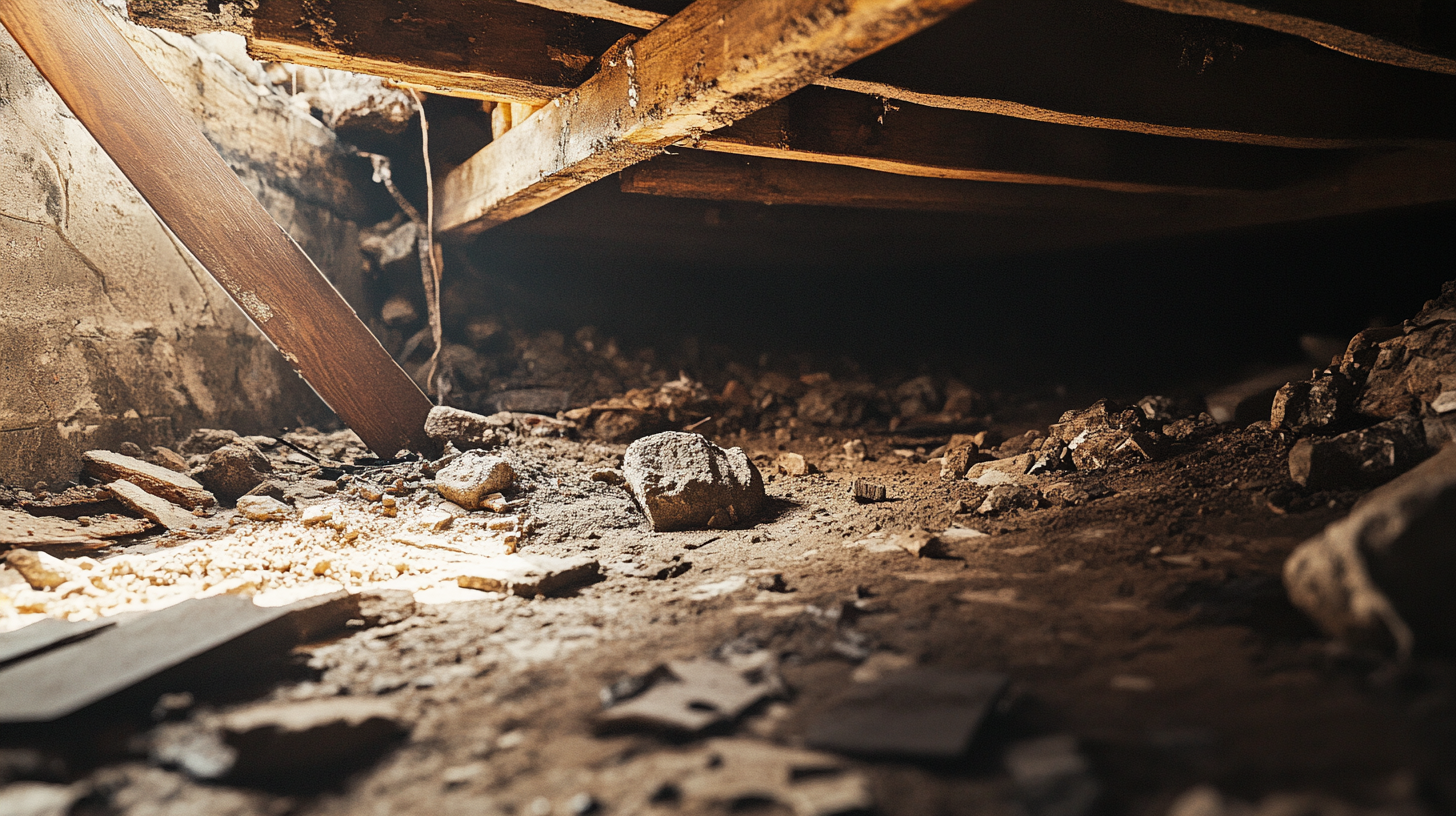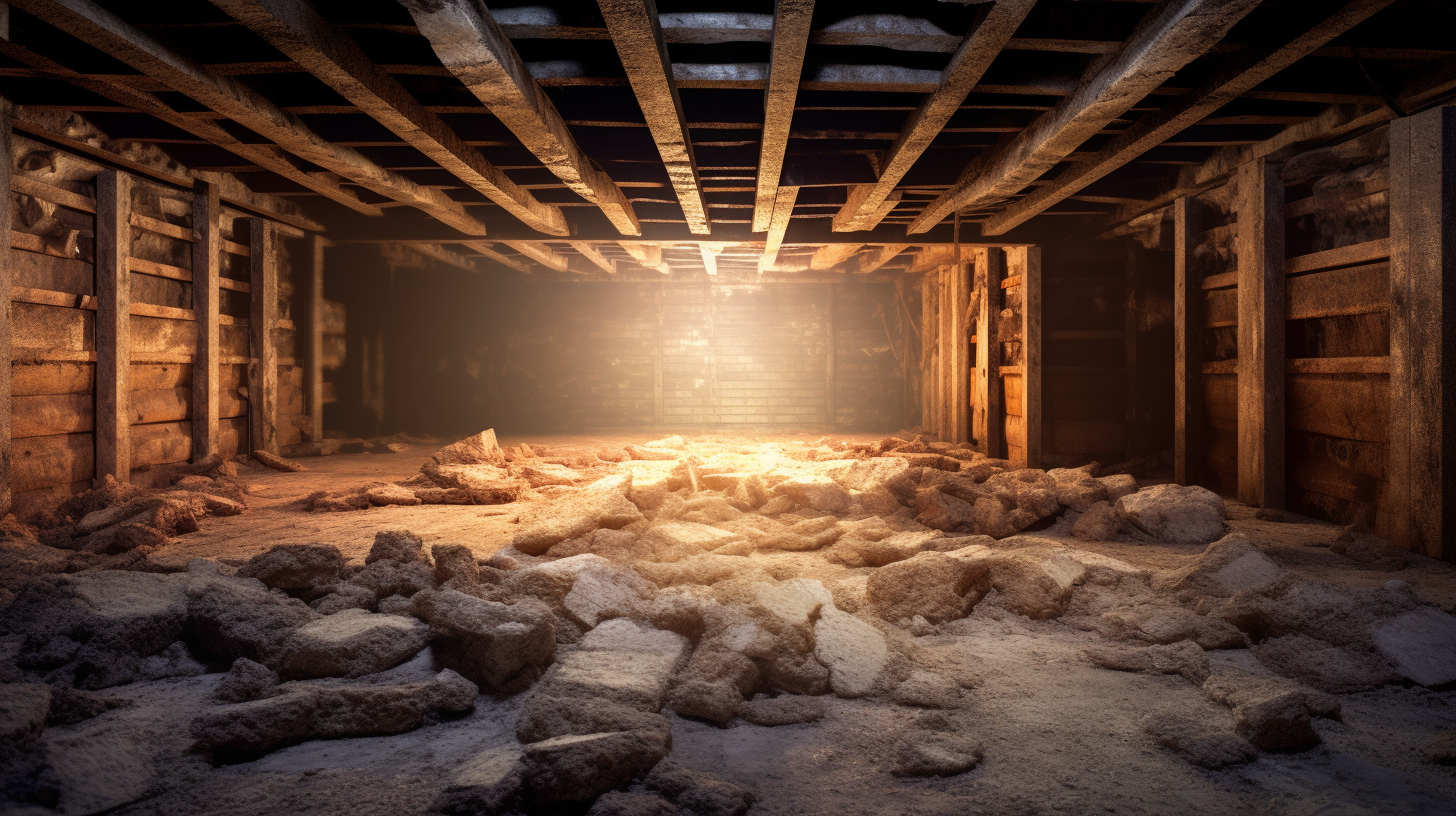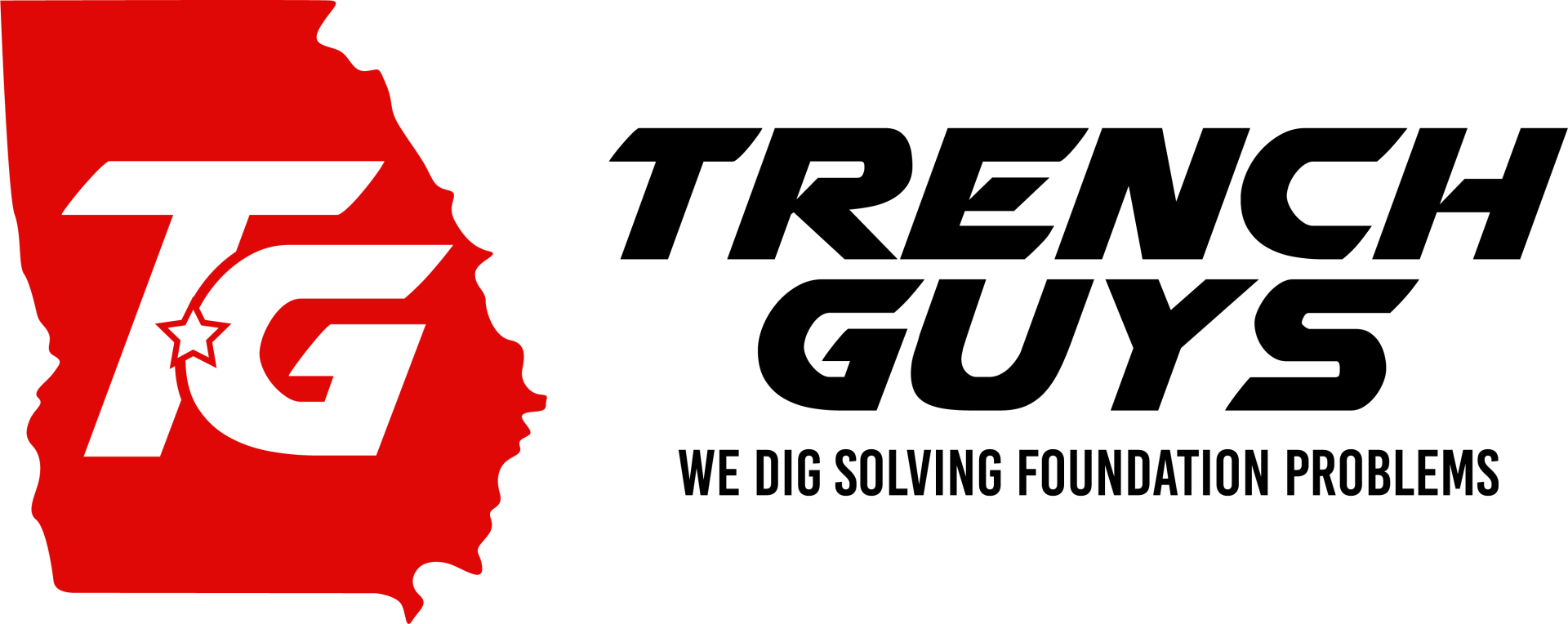Often hidden beneath the surface and out of sight, crawl spaces play a pivotal role in maintaining your home's stability and health. Serving as a buffer between your living areas and the ground below, crawl spaces are essential for providing foundational support, housing important utility connections, and promoting air circulation. However, despite their importance, crawl spaces are frequently overlooked during routine home maintenance.
This lack of attention can lead to a host of issues that can compromise your entire home’s structure, including moisture buildup, wood rot, pest infestations, and even foundational shifts. The health of your crawl space directly affects your home's stability, impacting everything from energy efficiency to the quality of the air you breathe. A well-maintained crawl space ensures that your home remains structurally sound and safe, while a neglected one can quickly turn into a source of significant, expensive problems.
In this blog, we'll uncover the significance of crawl spaces in maintaining home stability, exploring how proper ventilation, moisture control, and foundational repairs are crucial in preserving the longevity of your home. By understanding the specific challenges faced by crawl spaces and the best practices for managing them, you can ensure your home remains a sturdy and secure environment for years to come.
Common Pests Found in Crawl Spaces
Crawl spaces, with their dark, enclosed environments and occasional moisture, can be ideal habitats for various pests that can cause significant damage to your home. Here is a closer look at the most common types of pests found in crawl spaces, their habitats, and how they can affect your home’s structural integrity and living environment.
Types of Pests and Their Habitats
Termites
Termites are notorious for their ability to destroy wooden structures, posing a severe risk to the structural stability of your home.
- Habitat and Behavior: Termites are attracted to moist, dark environments, which makes crawl spaces an inviting habitat. They build colonies underground and burrow into wooden beams, joists, and other structural components to feed on cellulose-rich material.
- Impact: Over time, termites can cause significant wood damage, weakening support structures and compromising your home’s stability.
Carpenter Ants
Carpenter ants are known for hollowing out wood to create nesting areas, causing structural damage.
- Habitat and Behavior: Unlike termites, carpenter ants do not eat wood but excavate it to form extensive tunnel systems for nesting. They prefer moist, decaying wood, making crawl spaces an attractive habitat, especially where water leaks are present.
- Impact: While they don't consume wood, their excavation can weaken structural elements and increase the risk of mold growth.
Rats and Mice
Rodents are common in crawl spaces, where they gnaw and nest, causing property damage.
- Habitat and Behavior: Rats and mice are drawn to crawl spaces for nesting and foraging, particularly if they can find food sources or openings that connect to the home’s interior. They gnaw through insulation, wires, and wooden structures to build nests and gain access to living spaces.
- Impact: Their gnawing can cause damage to the structural and electrical systems, while their droppings create potential health risks.
Other Pests (Spiders, Beetles, and Woodlice)
Various other pests find crawl spaces appealing due to the environment's humidity and darkness.
- Habitat and Behavior:
- Spiders: Build webs and prey on other insects, often in damp corners of the crawl space.
- Beetles: Some beetles, such as powderpost beetles, lay eggs in untreated wood, and their larvae can bore holes as they feed.
- Woodlice: Prefer decaying wood and other organic material in moist environments.
- Impact: While these pests may not cause structural damage directly, their presence often indicates moisture issues that can lead to wood rot, mold growth, and attract other, more destructive pests.
Regular inspections and appropriate pest control measures can help prevent infestations and protect the structural integrity of your crawl space. Identifying these pests early and understanding their behaviors will help you take timely actions to maintain a pest-free, healthy home environment.
Signs of Pest Infestation in Crawl Spaces
Pest infestations in crawl spaces can lead to severe structural damage and health risks if not addressed promptly. Early identification of these issues can help you take swift action to mitigate the damage and safeguard your home. Here are the key visual and auditory signs that suggest the presence of pests in your crawl space.
Visual Signs of Infestation
Identifying visual signs is crucial in detecting a pest infestation. Keep an eye out for the following indicators:
- Mud Tubes: Termites construct mud tubes to travel between the soil and the wood they consume. These pencil-thin tubes are often found along foundation walls and other wooden structures and are a telltale sign of termite activity.
- Hollow Wood: Termites and carpenter ants burrow into wooden beams and joists, leaving behind a hollowed structure. Tap the wood gently to listen for hollow sounds or examine for surface cracks, which can indicate internal damage.
- Frass (Wood Dust): Boring insects like carpenter ants and beetles leave behind a fine, sawdust-like material called frass, which can accumulate around wooden structures or in small piles near their nests.
- Nesting Materials and Droppings: Rats and mice use shredded paper, fabric, or insulation to build nests, leaving behind scattered debris. They also produce droppings that can be found in corners and along pathways where they travel.
Spotting these visual signs early can prevent further damage, and scheduling regular inspections is essential to catch these indicators before the infestation becomes too severe.
Auditory Cues
While many pests hide from sight, they often produce distinct sounds that can indicate their presence:
- Sounds of Movement: Listen for the rustling or scampering sounds of rodents moving around in the crawl space. These noises may be faint and are often more noticeable at night when the house is quiet.
- Chewing or Gnawing Noises: The chewing sounds of rats, mice, or insects feeding on wood or wiring can often be heard in the crawl space, particularly at night.
- Insect Activity: Some insects, particularly termites, can be heard tapping or rustling as they eat through wood, especially when the infestation is large.
These auditory cues are particularly important when visual signs are challenging to detect. Investigating the source of these noises can confirm the presence of pests and enable you to take action before they cause extensive damage.
How Pest Infestations Impact Crawl Space Structures
Pest infestations in crawl spaces can have dire consequences for both the structural integrity of your home and the health and safety of its occupants. Understanding these impacts is essential for effective prevention and mitigation.
Structural Damage
Pests can cause significant structural damage to wooden beams, joists, and insulation in crawl spaces, often going unnoticed until the problem becomes severe.
Wood Damage
Wood is particularly vulnerable to pests like termites and carpenter ants, which feed on or tunnel through it, weakening its structural integrity:
- Termites: Termites consume wood from the inside out, making beams and joists hollow and fragile. They compromise the structural stability of the entire home, often without showing any immediate surface damage. Over time, this can lead to sagging floors, weakened foundations, and in extreme cases, structural collapse.
- Carpenter Ants: While they don't eat wood, carpenter ants hollow out wooden structures to create nests. This can lead to extensive tunneling through beams and joists, which eventually compromises the structure's ability to bear loads.
Insulation Damage
Rodents like rats and mice are known to burrow into crawl space insulation to build nests, causing significant damage to the material:
- Reduced Thermal Efficiency: Damaged insulation loses its ability to maintain the temperature balance between the crawl space and the living areas above. This results in increased energy costs as heating and cooling systems have to work harder to maintain a comfortable environment.
- Exposure Risks: When insulation is torn apart or degraded, it exposes wooden beams and pipes, increasing the risk of further pest infestations and creating potential hazards such as water leaks and moisture buildup.
Health and Safety Risks
Pest infestations not only impact structural integrity but can also pose serious health and safety risks to your household:
- Allergens from Pest Droppings: Rodents and insects leave droppings that can contain harmful pathogens and allergens. Over time, these droppings can build up in crawl spaces and find their way into the living areas, exacerbating allergies, respiratory conditions, and other health problems.
- Increased Risk of Electrical Fires: Rodents frequently chew through electrical wiring, exposing live wires and increasing the risk of electrical shorts or fires. This can be particularly dangerous in a crawl space, where fires can quickly spread to the main levels of the house.
Preventative Measures to Protect Crawl Spaces
Taking proactive steps to secure your crawl space is crucial for maintaining the health, safety, and structural integrity of your home. Preventive measures, such as regular inspections and physical barriers, are the first line of defense against pests, moisture, and other factors that can compromise this critical area.
Regular Inspections
Importance of Periodic Professional Inspections
Having your crawl space inspected periodically by a professional is vital. Professionals can identify subtle signs of structural issues, moisture accumulation, and pest infestations that might go unnoticed by the untrained eye. They bring specialized equipment and expertise that can:
- Detect early signs of termite and rodent activity, including hidden nests and entry points.
- Measure moisture levels to determine if there is excess humidity or standing water that might attract pests.
- Assess the overall condition of structural elements like beams and joists, insulation, and vapor barriers to ensure they are in good shape.
Regular professional inspections help catch problems before they escalate, saving you from costly repairs down the road.
DIY Inspection Tips: What to Look For and When
In between professional inspections, homeowners should conduct their own regular checks of the crawl space. Here’s what to look for:
- Visual Signs of Pests: Check for droppings, gnawed wood, mud tubes, or burrows that could indicate the presence of termites, rodents, or other pests.
- Moisture and Water Leaks: Look for puddles, mold growth, or rusted pipes, which may suggest leaks or inadequate drainage.
- Structural Issues: Inspect wooden beams for sagging or cracking, which might signal termite damage or decay.
- Insulation Health: Check for damp, degraded, or displaced insulation that could be caused by leaks or pests.
- Frequency: Conduct DIY inspections seasonally, especially during or after periods of high rainfall, humidity, or temperature changes.
Physical Barriers
Installation of Barriers and Shields to Prevent Entry
Physical barriers and shields are essential in preventing pests and moisture from entering your crawl space:
- Vapor Barriers: Install vapor barriers on the crawl space floor and walls to reduce ground moisture levels and make the space less appealing to pests.
- Mesh Screens: Place screens over vents and access doors to keep out small animals and insects.
- Metal Shields: For foundations prone to termite infestations, install metal shields that prevent termites from gaining access to wooden structures.
- Gravel Layers: Adding gravel around the foundation perimeter can discourage burrowing pests.
Proper Sealing of All Entry Points, Including Vents and Piping
Ensuring all potential entry points to your crawl space are properly sealed is crucial:
- Seal Cracks and Gaps: Use caulking or foam insulation to seal any gaps or cracks around the foundation, vents, and piping.
- Vent Covers: Install vent covers to block off unused vents that could otherwise serve as entry points for pests.
- Pipe Penetrations: Where pipes pass through the foundation or walls, apply sealant to close any gaps that might let in rodents or insects.
These preventive measures can help secure your crawl space and reduce the risk of pest infestations, moisture damage, and structural deterioration. By combining regular inspections with strategic physical barriers, you can maintain a healthy and safe crawl space environment.
Effective Solutions for Handling Pest Infestations
Crawl spaces, if not properly managed, can easily become a haven for pests. Handling infestations effectively requires a combination of immediate treatments and sustainable long-term strategies to prevent recurrence. Here’s a comprehensive guide to natural and chemical remedies, and sustainable practices that help keep pests at bay.
Natural Remedies and Deterrents
Natural remedies are useful for deterring pests and can be particularly helpful in preventing minor infestations:
- Essential Oils: Certain essential oils like peppermint, tea tree, and cedarwood are known to repel rodents and insects. Soak cotton balls in these oils and place them around the crawl space to create a deterrent barrier. Reapply regularly for consistent effectiveness.
- Predator Scents: Some animal-based repellents mimic the scent of natural predators like foxes and wolves, which can frighten smaller pests such as rodents. Predator urine or commercial scent products can be applied around the crawl space perimeter to deter rats, mice, and other small mammals.
- Natural Predators: Encouraging natural predators like owls or cats in the surrounding environment can help control the rodent population.
While natural remedies are gentle and environmentally friendly, they work best as preventative measures or supplementary solutions alongside other treatment strategies.
Chemical Treatments
When infestations have already taken hold, chemical treatments can provide effective and immediate control:
- Pesticides and Insecticides: These chemicals target specific pests like termites or ants. They are available in sprays, baits, and powders that can be placed strategically in the crawl space. However, they should be used carefully to avoid health hazards.
- Safety Guidelines:
- Follow all label instructions strictly to prevent accidents and ensure effectiveness.
- Wear protective clothing and equipment to minimize exposure.
- Keep children and pets away from treated areas until the chemicals have settled or dried.
- Professional Pest Control Services: For severe infestations or when chemical treatments are necessary but hazardous, professional pest control services can be crucial. Pest control experts can:
- Accurately identify pest species and the scale of the problem.
- Apply targeted treatments safely and effectively.
- Recommend preventive measures to reduce future infestations.
Long-Term Management Strategies
Long-term strategies are essential for maintaining a pest-free crawl space after treatment. Here are some effective practices:
- Maintenance Routines:
- Conduct regular inspections to detect early signs of pest activity.
- Keep the crawl space clean and free of debris that could attract pests.
- Remove any food sources or stagnant water that might encourage rodents or insects.
- Environmental Modifications:
- Moisture Control: Install dehumidifiers, vapor barriers, and drainage systems to reduce moisture levels, making the crawl space less hospitable to pests like termites and ants.
- Physical Barriers: Seal cracks, gaps, and potential entry points. Use mesh screens or vent covers to block small animals and insects.
- Landscaping: Trim back bushes, trees, or other vegetation that might provide easy access to the crawl space.
By implementing these solutions and strategies, homeowners can manage existing infestations effectively and protect their crawl spaces from future pest problems.
FAQs
Contact Trench Guys Today!
Trench Guys will do everything we can to ensure your experience with us is excellent.
Request A FREE Estimate
Request a Free Estimate Form
Checkout Recent Post




Got a Question? We’re Here to Help.
You can arrange an appointment or make an enquiry by phone or email, orget in touch to us via our contact form.



